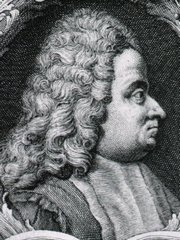This article is part of the series "A Moment in History" where we honor those who have contributed to the growth of medical knowledge in the areas of anatomy, medicine, surgery, and medical research.

Antonio Maria Valsalva
Antonio Maria Valsalva (1666 – 1723). Italian physician, surgeon, pathologist and anatomist, Antonio Maria Pini was born in the city of Imola. His father Pompeo Pini, a well-to-do goldsmith, adopted the family name Valsalva based on the location of his grandfather’s castle. Valsalva was well educated by Jesuits in mathematics, natural sciences and humanities, and continued his studies in Bologna, where he was trained in anatomy by Marcello Malpighi (1628 – 1694).
In 1687, at the age of 21, Valsalva received his Doctorate in Medicine and Philosophy. He was very dedicated to the practice of medicine, research and anatomical studies. Because of his anatomical knowledge he routinely used cadaver dissection in his clinical practice, advancing his knowledge as a pathologist. In 1694 he was appointed Professor of Anatomy at the University of Bologna.
One of his areas of interest was the anatomy of the hearing system, and his only known publication in 1704 is “De Aure Humana Tractatus” (The Study of the Human Ear) , where he described the ear as composed of the three regions known to us today: internal, middle, and external.
He described a maneuver to inflate the middle ear to erase deafness and increase suppuration caused by middle ear congestion. This is known today as the Valsalva maneuver used in medical practice, but also in deep sea diving and by pilots to clear the middle ear and balance the air pressure in the middle ear with that of the external environment. Today the cardiophysiological bodily response to Valsalva’s maneuver has been studied in detail.
Valsalva is responsible for the eponym “Eustachian tube” that refers to the muscular tube communicating the superior aspect of the pharynx (rhinopharynx) with the middle ear. He did dissections to study in detail the aorta and aortic valve, describing what today are known as the “sinuses of Valsalva”, a pocket-like dilation of the aortic valve between the aortic valve wall and the valve cusps (leaflets). Each of the coronary arteries arises from a sinus of Valsalva. Similar sinuses are found in the pulmonary valve.
During his studies of the mentally ill, Valsalva was of the opinion that madness was an organic disease and therefore mentally ill patients deserved humanitarian treatment, which was not the standard during his times.
One of his best students and pupil was Giovanni Battista Morgagni (1682-1771) who, after the death of Valsalva in 1723, used some of his unpublished material to complement his own studies and publications.
Besides the Valsalva maneuver and the sinuses of Valsalva, there are other eponyms that honor this great anatomist:
• Valsalva Antrum or mastoid antrum is a cavity in the petrous portion of the temporal bone.
• Valsalva’s ligament attaches the pinna to the side of the head.
• Valsalva’s muscle: a band of vertical muscular fibers on the outer surface of the tragus of the ear, innervated by the temporal branch of the facial nerve
Sources:
1. “Seeing the Anatomy of Hearing: New Tools and Approaches Chart the Pathways Underlying How We Process and Integrate Sound” Laitman, JT The Anatomical Record (2006) 288A:323–324
2. “Antonio Maria Valsalva - Biographical Profile of a Pioneer on Otology” Meirelles, RC et al Int. Arch Otorhinolaryngol (2008)12: 2, 274-279
3. “The Valsalva manoeuvre and Antonio Valsalva (1666-1723)” J R Soc Med. (2006) 99(9): 448–451
4. “A short biography on the life of the dedicated anatomist –Valsalva” Kazi, R . J Postgrad Med (2004) 50:314-5
5. “Antonio Maria Valsalva (1666 – 1723)” Yale SH Clin Med Res (2005) 3(1): 35–38
Original image courtesy of the National Library of Medicine



